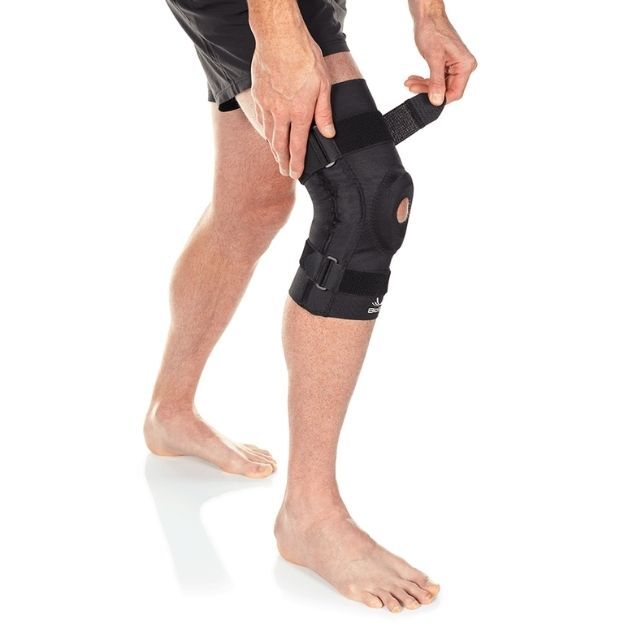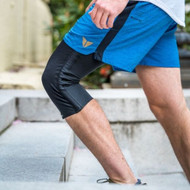If your knee feels shaky after a twist or surgery, ACL knee support adds comfort and stability. Your diagnosis, rehab plan, and return-to-sport green light should come from your clinician. Research is mixed on routine post-op bracing and long-term outcomes, yet many people still use a brace for protection and confidence during activity.
In the sections ahead, we’ll help you match support to your stage so you can move forward with clarity.
What ACL Knee Support Means
The anterior cruciate ligament helps keep the knee from sliding in ways that strain tissues. After an ACL injury, the job of knee support is to limit risky side-to-side motion while still letting you bend and straighten naturally.
Here’s how the main categories differ, in plain terms:
Compression sleeve
A soft sleeve provides uniform compression to manage swelling and ease knee pain. It adds comfort and body awareness but does not deliver primary ACL stability. Many people use a sleeve during light activity or under another brace.
Lightweight hinged sleeve
This is the common “ACL knee brace” for daily movement. Low-profile hinges and adjustable straps add external control against varus/valgus forces and help you feel steadier as you rehab. It’s a practical step when you want more knee stability without bulky hardware.
High-stability hinged brace
This is the next level of control when your knee needs structured guidance. A high-stability hinged design often uses longer uprights and adjustable range-of-motion (ROM) hinges to set safe bending limits during recovery.
It’s typically used for post-surgical protection or when instability is significant. The goal is to allow controlled motion while you rebuild strength and movement mechanics under your clinician’s direction.
An unloader brace shifts pressure away from the affected compartment of the knee, reducing discomfort from arthritis or uneven load patterns. While it’s not designed for primary ACL control, it can complement recovery for people managing both ligament injury and arthritic changes, depending on your clinician’s recommendation.
Your Option A: Knee Compression Sleeve

Start here when your knee feels puffy or achy but not wobbly. A compression sleeve adds consistent pressure to manage everyday swelling and improve comfort during recovery.
It also boosts proprioception—the body’s sense of joint position—so you’re more aware of where the knee is in space, cueing safer mechanics and helping you avoid risky, end-range motions that can aggravate tissues. It is useful support for knee injuries that don’t require rigid control.
What it’s for
High, steady compression to help reduce day-to-day inflammation and provide mild support during regular brace usage in early rehabilitation or light activity. It’s not a substitute for ligament stability and isn’t an ACL brace—if your knee gives way, a hinged option belongs on your list.
When it helps
Desk days, walks, easy gym sessions, or worn under a hinged brace as a comfort layer. Many athletes also like a sleeve after workouts to dial down post-activity swelling and general knee pain.
Your Option B: Hinged Knee Sleeve

When your knee feels a little wobbly but you still need to move, this is the step up from a sleeve. A hinged knee sleeve uses lightweight aluminum hinges with top and bottom straps to add external control against side-to-side (varus/valgus) stress while keeping bulk low. You still bend and straighten normally; the goal is steadier motion and a more confident stride during recovery.
What it is
A low-profile brace that combines compression with stabilizing hinges. The design helps provide support and can help reduce strain on tissues that feel vulnerable after sprains or other knee injuries without heavy hardware or rigid plastic shells.
When it helps
Great for mild-to-moderate instability and everyday activities, such as walking, light workouts, or getting back to routine tasks. Many people use it as they progress through rehabilitation, when they want added control against side-to-side motion but don’t need a high-stability post-op brace.
How to Choose By Stage
Match the brace to where you are in recovery, and follow your clinician’s guidance. A brace can provide support and comfort, but it isn’t a cure or a guarantee to prevent injury.
Right after injury/early post-op
Prioritize a high-stability hinged design with ROM control. Uprights along the femur and tibia help limit side-to-side motion while you start gentle physical therapy. ROM hinge settings come from your surgeon/PT to protect the joint and avoid further injury.
Rehab & daily movement
As swelling settles and mobility improves, a lightweight hinged sleeve can add functional stability for walking, light activity, and routine tasks. If day-to-day soreness lingers, layer a compression sleeve for comfort and swelling control. Stop and reassess if pain or swelling increases.
Later phases/uneven ground confidence
Stick with the hinged option your clinician recommends for higher-risk moments (stairs, trails, quick direction changes). Many people gradually transition to lighter support or sleeve-only for comfort as strength and control return. The goal is simple: steady progress with smart loading, not shortcuts.
Find Your BioSkin ACL Support
Pick the level of help that matches where you are right now, then keep your momentum with a clear plan.
- Choose your support:
- Compression sleeve for swelling control and comfort.
- Hinged sleeve for everyday functional stability.
- Bodyguard (Gladiator) for higher-control needs per your clinician.
- Check sizing: Use the product size chart, measure at the noted landmarks, and select a snug—not tight—fit.
- Pair with rehab: Wear your brace as directed and follow a clinician-guided program for strength, mobility, and gradual progress.
Choose your BioSkin ACL support and size to get started today!
Frequently Asked Questions
Do knee braces help with ACL tears and knee pain in the knee joint?
They can add external stability and comfort, especially against side-to-side stress, but they don’t heal the ligament. Use them alongside clinician-guided rehab to protect movement while you rebuild strength.
What makes an ACL knee brace different from other functional braces, and how does it provide support?
An ACL knee brace typically uses lightweight hinges and straps to limit risky motion, while many functional braces target different needs (e.g., patellar tracking or unloading for arthritis). Both can provide support, but ACL stability usually calls for a hinged design.
How do I choose the right brace from ACL braces for my situation?
Match support to symptoms and stage: a compression sleeve for swelling/comfort, a lightweight hinged option for everyday instability, and a high-stability hinged brace for post-injury or post-op, per your clinician. Fit should be snug, not tight, with no numbness.


 US Dollars
US Dollars
